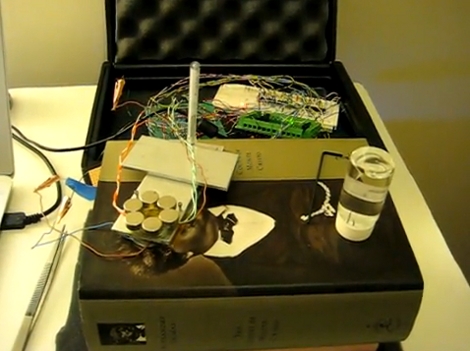
ChemHacker has posted schematics and code for a scanning tunneling microscope. [Sacha De’Angeli] finalized the proof-of-concept design for version 0.1 and released all of the information under the Gnu general public license version 3. You’ll need to build a sensor from a combination of a needle, a piezo, and a ring of magnets. There’s an analog circuit that gathers data from the probe, which is then formatted by and Arduino and sent to your computer.
We haven’t really dabbled in this type of equipment, though we did cover an STM earlier in the year. Take a look at the video after the break and then help jump-start are imagination by sharing your plans for this equipment in the comments.
[youtube=http://www.youtube.com/watch?v=IZmCc2sAHiE]















did I miss the end result images?
“are” imagination? (our imagination)
yeah, it seemed kinda weird to me too that they didn’t have any actual data to display?
jump-start are imagination
s/are/our/
You two should probably read the page. He is at the proof of concept stage.
It’s based on a design that’s been kicking around the web for over ten years. I built one myself (using a Burleigh controller)– works sort of, but the scanner is extremely non-linear so it’s pretty limited. I think they should pony up the ~$100 for a decent piezo and build the design around that.
I did read the page, he has everything setup and testing, so show an image, even a crappy one would have been cool
just saying
I’m not sure if people are aware of an open source SPM controller software:
http://gxsm.sourceforge.net/index.php
My virus killer pops up when going to their website. HTML/framer.
They had a proper one at uni i was at. the entire equipment was mounted on a vibration isolating table there very vulnerable to vibration.
So dump your scanner, it obviously sucks.
“still figuring out how to get a stable trace”
So basically it’s not working, and it might never.
Soo… it’s not done … or even close to done then? And they GPL’d this crap… and posted a video of it doing nothing… because why?
Just had a quick read about STM’s, and how extremely precise the tech is, the expense, and how sensitive they are to the environment. The tolerances are extreme. This is just way too crude to work.
I’m gonna bet this guy built it as a theoretical model more than a working atomic level microscope.
Maybe he can image something on a much larger scale? But I don’t think this works anywhere near the operation of a real STM.
A similar project from a while back:
http://sxm4.uni-muenster.de/stm%2Den/
@JJ yeah I think having it on some dinky table on some foam might not be quite enough, you need a setup like they use to make holograms.
The (interesting) link provided by Scott Torborg above has this to say on that subject:
“A basic requirement for the mechanical construction is efficient dampening of acustical noise in the range of some 10Hz (steps). This is reached by assembling the components in a very small set-up and to connect them as stiff as possible (glueing should be done with a 2-component-epoxyd)
Additonal dampening can be reached by the following methods: 1. put the STM on a heavy plate, which is resting on a air-tube, 2. put the microscope on a heavy plate which is suspended by rubber tubes or 3. put the micrsocope into a tub with filled with fine sand”
(I left the spelling errors in since it’s a quote)
Addendum: A book might be heavy but it doesn’t have the solidity to equal a solid plate, I know that from experience.
Having no pictures is not all that surprising. My wife did her phd thesis in the construction of an stm (this was in 1990-1995) and didn’t have a single picture for years (and years and years).
You might be interested to know: Her supervisor spent something like $300k+ constructing this ultra high vacuum stm, and in the 4th year a salesman approached him with an in-air stm for $50k. Closest I’ve ever seen him cry.